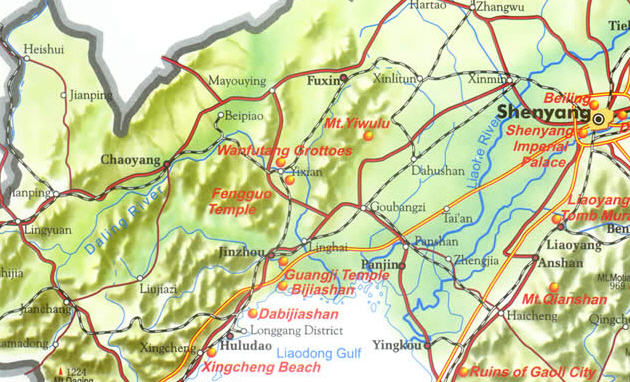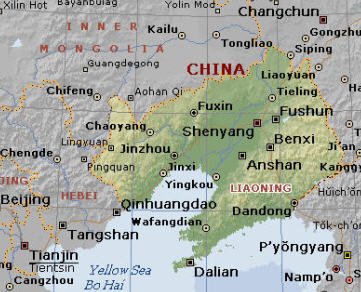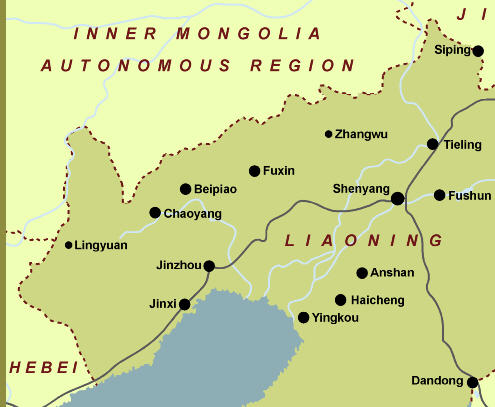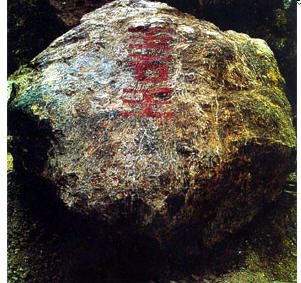
|
Subject:The Exact Locations of two Famous Hongshan sites
Posted By: Bill Mon, Oct 01, 2007
Dear Dr. Valeanu:
It was never my intention to show any disrespect toward any of your opinions. You have shown nothing but kindness toward me since you have joined this forum, unlike many other so-called jade experts and therefore I am extremely grateful. I believe I just got caught up in the fervor of debating when you concluded that "Hongshan Culture" was not a "Chinese Culture" but instead a "Mongolian Culture" and your stating that while nephrite could be found easily at Xiu Yan and Anshan, Liaoning but 98% of the authentic Hongshan jades were made of Bowenite (a type of serpentine).
My friend, B, actually did not disagree with you in that Hongshan culture might be a "Mongolian Culture" since some of the Hongshan artifacts were indeed discovered in the area of today's Inner Mongolia (Chifeng, which is outside the Great Wall). However, many other Hongshan site were found inside the Liaoning Province in China, such as the Niuheliang site. We also have to remember that the complete Hongshan territory is rather vast and its history is very long. There are many different minority races and cultures had probably co-inhibited in the such a vast area during the neolithic and bronze ages. Without further studies, I am simply not in a position to conclude whether the Hongshan Culture is indeed a pure Chinese Culture or if it is a pure Mongholian Culture or may be it is indeed a combination of many different cultures co-existed at the same time in the area.
*************************************************
There is a google book titled:
"The Archaeology of Northeast China: Beyond the Great Wall
By Sarah Milledge Nelson"
http://books.google.com/books?id=KDtgLQfEGBsC&pg=PA59&lpg=PA59&dq=chifeng&source=web&ots=HD-3KtFfXn&sig=qFlHTwJ8tzG_V13JwNZdUdWv1Yk#PPA58,M1
In the book the author discussed the discovery, origins and geography of Hongshan culture and she also discussed an essay written by Professor Guo Da-shun, the Hongshan guru, in the belief that Hongshan culture was indeed a Chinese culture. The author said the readers should draw their own conclusion. However, even she agreed that Hongshan culture might have a great impact on the Chinese culture since the time of Huang Di (Yellow Emperor) which was the era prior to the Xia dynasty. I have not got the chance to read the complete book yet (you have to purchase then whole book) and without doing further researches I am not in a position to render any opinions on the exact origins of the Hongshan culture. Incidentally, the person whom I believe can shed the most light in this subject will be Diasai who has been spending a lot of time in the studying of Hongshan culture. His knowledge in Hongshan is simply vast comparing with a lot of other members in this forum.
*************************************************
Once again, if you refer to this link:
http://zh.wikipedia.org/w/index.php?title=%E8%BE%BD%E5%AE%81%E7%9C%81&variant=zh-hk
It shows that Liaoning has always been a part of China since the Xia dynasty.
I had already shown Chaoyan had always been a part of China in a separate message and I am not going to repeat it here.
*************************************************
Now let us look at the exact locations of two of the most famous Hongshan sites:
(1) The Niuheliang
http://211.86.193.14/%E8%8B%B1%E8%AF%AD%E5%9C%A8%E7%BA%BF/culture/ChinaCulture/ChinaCulture/en_travel/2003-09/24/content_33554.htm
The Niuheliang Site is located on the border of Lingyuan County and Jianping County, Liaoning Province.
The site, spreading over ten areas of more than 50 square kilometers, was discovered in 1981 and consists of the Temple of the Goddess and stone tombs. It belongs to the Neolithic Hongshan Culture that dates back 5,000 years.”
http://whc.unesco.org/en/tentativelists/141/
China (Asia and the Pacific)
Date of Submission: 12/02/1996
Criteria: (iii)(iv)
Category: Cultural
Submission prepared by:
State Bureau of Cultural Relics
Coordinates:
Chaoyang city - Liaoning Province Long. 119°30' East Lat. 41°20' North
Description
Niuheliang archaeological site, situated at the upper reaches of Dalinghe river and in the valley of Nuluerhu Mountain, belongs to the late Neolithic Hongshan Culture, which ages 3500 BC. It is a complex archaeological site made up of the Goddess Temple and the northern platform, the cairns and altar. it covers an area of 50 Km. The Goddess Temple, located on the top of the main ridge, is in subterranean civil structure. The area of the remained undergroud part is 75m, with one meter deep. The clay goddess statues, mural paintings and the painted pottery were unearthed. The cairns located on the top of the surrounding two hills were layed into square or round stepped tomb mound with limestone. Most of these tombs covers an area above 400m, and attached with painted cylindrical ware in rows. There is the large central burial inside the tomb with burial dragons, tortoises, bire-shaped pendants and jade hoops etc. The altar between the tombs is annular stone-fenced with three layers. There is a "pyramid" shaped building with earth and stone structure at the southern low hill, and the diameter of the stone steps is 60m. the sites are distributed along the trend of the mountain in line with the south-north axis, high echoing low and primary and secondary is distinct. The large scope building groups mainly with religious sacrifice, forming the center of the highest gradation of Honshan Culture are the positiveness to enter the ancient state age from Liao river valley at "Five-Emperor" period 5000 years ago.
United Nations - Copyright © 1992-2007 UNESCO World Heritage Centre, All Rights Reserved | Terms / Policies | v3.0, Updated 01 Oct 2007
http://map.meet99.com/map/959/1170.htm
Satellite map for Chaoyang City and Liaoning province
http://zh.wikipedia.org/wiki/%E5%87%8C%E6%BA%90%E5%B8%82
(Translated)
Lingyaun County, Chaoyan City, Liaoning Province, China
“Lingyuan County is a county under the jurisdiction of the Liaoning Province, Chaoyan City. Its name “Ling Yuan” is originated from the fact that it was the source of the DaiLingHe (or Dai Ling River) (Yuan means origin or source, Ling is part of the name of the river.) The Niuheliang Hongshan site was found at the border of Lingyuan county and JianPing county.”
http://zh.wikipedia.org/w/index.php?title=%E5%BB%BA%E5%B9%B3%E5%8E%BF&variant=zh-hk
(translated)
“Jiangping County, Chaoyan City, Liaoning Province, China
The Jiangping County is under the jurisdiction of Chaoyan City, Liaoning Province. Total area of 4,838 square kilometer with a population of 5.8 million. Postal code is 122400.”
*************************************************
Before we go any further, we have to first understand the government structure in China in how they are classifying their city infrastructure. Unlike U.S.A., where county is bigger than city and many cities were within a county and under the jurisdiction of the county, it is very different in China. In China, the whole country was first divided into different provinces (sheng or xing), then each province will be further divided into different cities (shi) and each city will be divided into different counties (xian).
Therefore, the Niuheliang site is actually at the border of the Lingyuan County and Jianping County and both counties were part of the Chaoyan City (there is also a Chaoyan county within the Chaoyan city) and under its jurisdiction. The Chaooyan City is part of the Liaoning province and is under its jurisdiction.
On the other side, Anshan city where the large jade boulder was found is one of the cities inside Liaoning province and it is at the central southern part of Liaoning and the Niuheliang site is actually further away (northeast of it) from it and is not inside the Anshan city. The Xiu Yan county where most of the modern Xiu Yu (serpentine jades) are produced is inside the Anshan County. (Please see maps posted for more info)
More info for the Anshan city:
http://en.wikipedia.org/wiki/Anshan
Anshan (Chinese: 鞍山; pinyin: Ānshān; lit. 'saddle mountain') is a county in Liaoning province, China. It has a population of approximately 3.6 million.
Located in the center of Liaoning Province, Anshan is one of the open cities on Liaodong Peninsula. Anshan covers an area of about 9,252 square kilometers. The longest distance from the north of Anshan to the south is 175 kilometers, and the distance from east to west is 133 kilometers. Anshan is about 89 kilometers south of the capital of Liaoning, Shenyang.
http://zh.wikipedia.org/w/index.php?title=%E9%9E%8D%E5%B1%B1&variant=zh-hk
Anshan City (translated)
The Anshan City is located in the central southern part of Liaoning Province, and is a city under the jurisdiction of the Liaoning Province, is the one of the most important steel production base in China, has the title of “Capital of Steel”. …..
************************************************
Book for the Niuheliang site:
http://www.paragonbook.com/html/browsesubj/fullcitation.cfm?item=4541
牛和梁红山文化遗址与玉器精粹
Niuheliang Hongshan Wenhua Weizhi Yu Yuqi Jingcui
Hongshan Culture and Hongshan Jade at Niuheliang
辽宁省考古研究所
Liaoning Province Archaeological Research Team
7.3 x 10.2", 102 pp., 101 color illustrations, text in Chinese, Beijing, 1997.
A detailed investigation of the famous Hongshan site at Niuheliang, west part of the Liaoning province. Illustrated here are jade carvings, earthernwares, photographs of the site, and how the objects were found in the graves. Following the essays, each object and photograph is amply described. Text in Chinese.
*************************************************
(2) Chifeng
The other imporstant Hongshan site was found in Chifen which was located in the Inner Mongolian Region and is very close to Chaoyang (see map).
http://www.kaogu.cn/en/detail.asp?ProductID=1333
“INTRODUCTION
Chifeng is one of the few areas in China where modern archaeology stamped its first footprints (Fig. 1). Torii Ryuzo, a famous Japanese archaeologist, travelled through the eastern Mongolian Plateau from 1906 to 1908 and recorded a number of archaeological sites. The Hongshanhou site (Chifeng, Inner Mongolia), after which the well-known Hongshan culture was named, was found in his journey (Torii 1914). “
http://en.wikipedia.org/wiki/Chifeng
Chifeng (Chinese 赤峰, Pinyin Chìfēng, Wade-Giles Ch'ih-fêng; lit.: red peak; Mongolian: ulaγan qada (pronounced like Ulaankhad, lit. red cliff) is a prefecture-level city in southeastern Inner Mongolia. It borders Xilin Gol to the north and west, Tongliao to the northeast, and Chaoyang prefecture of Liaoning and Chengde prefecture of Hebei to the south. The city has an area of 90,275 km² and a population of 4.48 million (2004). Chifeng is the seat of a Roman Catholic diocese
http://www.encyclopedia.com/doc/1E1-Chifeng.html
Chifeng
From: The Columbia Encyclopedia, Sixth Edition | Date: 2007
Chifeng , city (1994 est. pop. 392,000), Inner Mongolian Autonomous Region, China. It is an agricultural distribution center, trading in wool, furs, hides, and grain. Coal and gold mines are nearby. It was called Ulan Hada by the Mongols, but in about 1778 it was colonized by the Chinese.
A book for the Hongshan jades found in the Chifeng site:
http://www.paragonbook.com/html/browsesubj/fullcitation.cfm?item=32239
红山玉器: 赤峰文物精华丛书
Hongshan Yuqi: Chifeng Wenwu Jinghua Congshu
Hongshan Jade: Essence of Chifeng Historical Relics Series
于建设
Yu, Jianshe
8.25 x 11.25", 204 pp., fully illustrated in color, text in Chinese with English captions, paper, map, Chifeng, 2005.
This is an important catalog on Chinese Jade from the Hongshan Culture in Chifeng County
**************************************************
Material of the Anshan Jade Buddha:
According to another message I just posted yesterday in which I quoted:
In 1984, the Liaoning Analyzing and Testing Research Institute had formed “The Analyzing team for the King of Jade” and traveled specifically to the adjacent area of the King of Jade. They performed complete testing on the jade boulder. With the assistance of special equipments, they obtained more than 700 3-dimensional points of the boulder, using x, y, z axis, they obtained an volume of 100.68 cubic meter for the boulder, with a specific gravity of 2.59 ton/cubic meter. Its total weight was 260.76 tons."
With a S.G. of 2.59, it is simply very unlikely that the jade Buddha can be made of nephrite but more likely of serpentine.
Incidentally, another much larger jade boulder was found in Anshan later and its size surpassed that of the previous jade boulder used to carve the jade buddha. However, it was described as "jade" without any specific information whether it is nephrite or serpentine.
On many Hongshan jade books, many of the Hongshan jade pieces were only described as "jade" without detailed description to its exact materials. Unless somebody can find some data refer to the exact material of all excavated Hongshan pieces and perform a statistical study, we may never know for sure whether it is true that most (and the exact percentage) of the authentic Hongshan jades were indeed made of serpentine. However, it can be proved that nephrite was indeed located inside the ancient Hongshan territory and were known for use in the carving of authentic Hongshan jades. Even today, small quantity of nephrites can be found around Anshan or Xiu Yan, however the quality of some of the nephrites were simply not the same quality of those found in the carving of archaic Hongshan jades. From my limited experience with Hongshan jades, many seeminly authentic Hongshan jades were carved in a celadon color (light green) high-quality nephrite jades resembles Hetian jades found in Xinjiang. This type of celadon nephrite will usually have a S.G. of 3.10 and a hardness of 6.5 (yes, that high). Due to such high quality and with the superb polishing skills of the Hongshan culture, the luster found on these jade pieces are simply exquisite and they shine like gems. One cannot mistake when one see one. Of course, without any other signs of "age" or close examination of carvings found on these pieces, it is not possible to confirm their authenticity. Of course, it is quite possible that high-quality Hongshan fakes can be made of similar Hetian jades but without the long-lost polishing skills of the Hongshan people, such fake pieces will simply look "wrong". Also, the cost of producing such fakes will outweigh the selling prices of some of these pieces.
Therefore, without further and in-depth studying of Hongshan cultures and its jades, any conclusion regarding its material, origins and authenticity will easily be erroneous or inaccurate. That is why I was hoping members in this forum would keep an open mind in the studying of Hongshan jades. Unfortunately, that is simply not the case. There seem to be more critics than true scholars.
Thank you for your indulgence.
Bill





|
 The Misconception that there is a large supply of Nephrite in the Current China
The Misconception that there is a large supply of Nephrite in the Current China  ( China & Japan ) - Bill - Sep 29, 2007 (02:14 PM)
( China & Japan ) - Bill - Sep 29, 2007 (02:14 PM)  The Story of the King of Jade and the BIG JADE BUDDHA
The Story of the King of Jade and the BIG JADE BUDDHA  - Bill - Sep 29, 2007 (11:36 PM)
- Bill - Sep 29, 2007 (11:36 PM)  No disrespect to anybody - Bill - Sep 30, 2007 (12:26 AM)
No disrespect to anybody - Bill - Sep 30, 2007 (12:26 AM)  Correction - Bill - Sep 30, 2007 (12:45 AM)
Correction - Bill - Sep 30, 2007 (12:45 AM)  Further evidence indicating a limit nephrite supply found inside the Current China - Bill - Sep 30, 2007 (06:02 PM)
Further evidence indicating a limit nephrite supply found inside the Current China - Bill - Sep 30, 2007 (06:02 PM)  Re: The Misconception that there is a large supply of Nephrite in the Current China - Mircea Veleanu - Sep 30, 2007 (10:54 PM)
Re: The Misconception that there is a large supply of Nephrite in the Current China - Mircea Veleanu - Sep 30, 2007 (10:54 PM)  The Exact Locations of two Famous Hongshan sites
The Exact Locations of two Famous Hongshan sites  - Bill - Oct 01, 2007 (12:11 PM)
- Bill - Oct 01, 2007 (12:11 PM)  Unique Area and Loacl Jades - Bill - Oct 08, 2007 (12:28 PM)
Unique Area and Loacl Jades - Bill - Oct 08, 2007 (12:28 PM)  Why don't you show me where I can get some cheap nephrite? - Bill - Oct 09, 2007 (03:07 PM)
Why don't you show me where I can get some cheap nephrite? - Bill - Oct 09, 2007 (03:07 PM) 





